Kyrgyz Fashion: Combining Tradition and Innovation

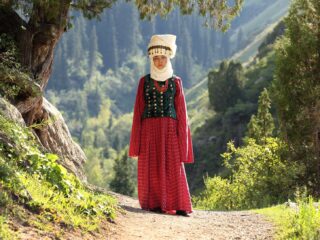
An artisan must always be an innovator: choosing and experimenting with new materials, techniques, ornaments, and shapes—but a good artisan must cherish traditions as well.
Kyrgyz craftsmen know how to make artistic objects for everyday life. For hundreds of years, the art of felt has been an essential part of the history, culture, and soul of Kyrgyz craft traditions. In today’s skillful hands, the felt creation process has been influenced by several innovations: hand-made embroidery has been replaced by automated machines, traditional felts have been supplemented with fancy fabrics such as silk, and traditional materials have been adapted into modern accessories. A colorful felt carpet, shyrdak or ala-kiyiz, is now transformed into a felt wall panel and felt slipper—or a high-crowned cap, ak-kalpak, into a baseball cap.
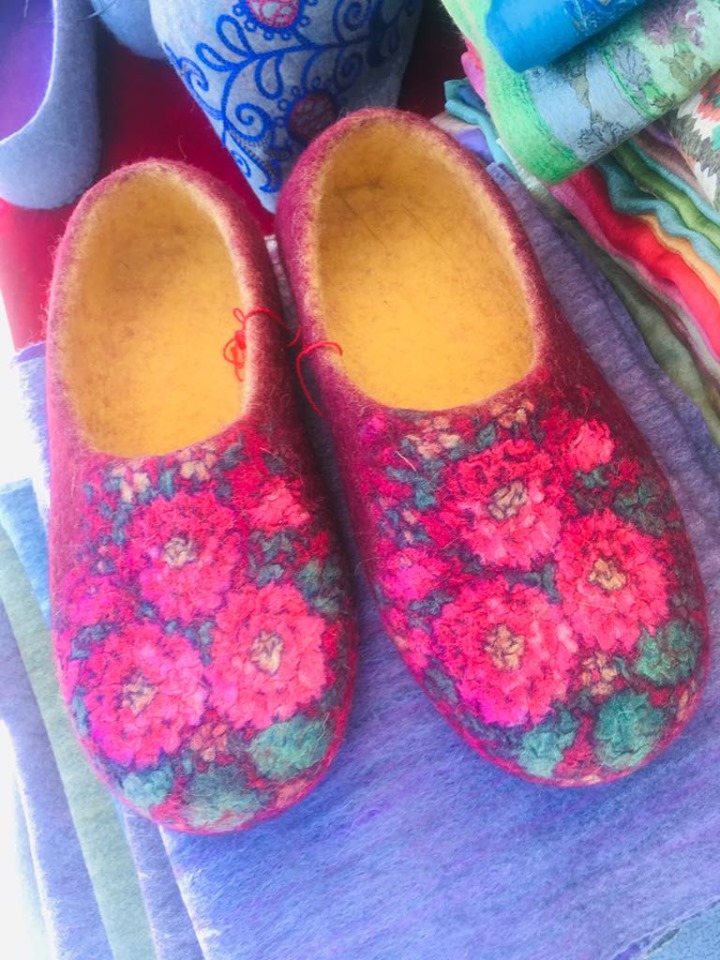
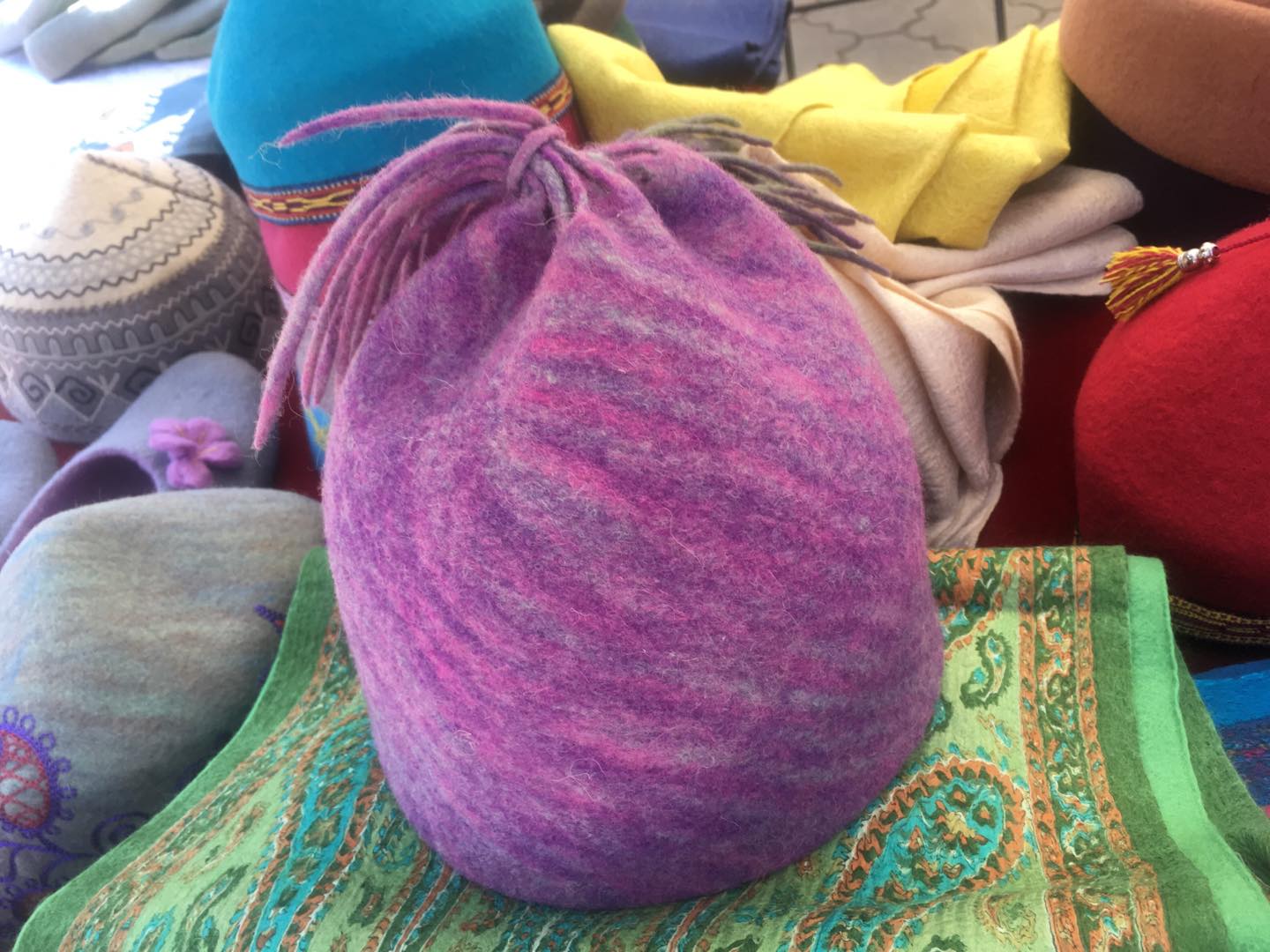
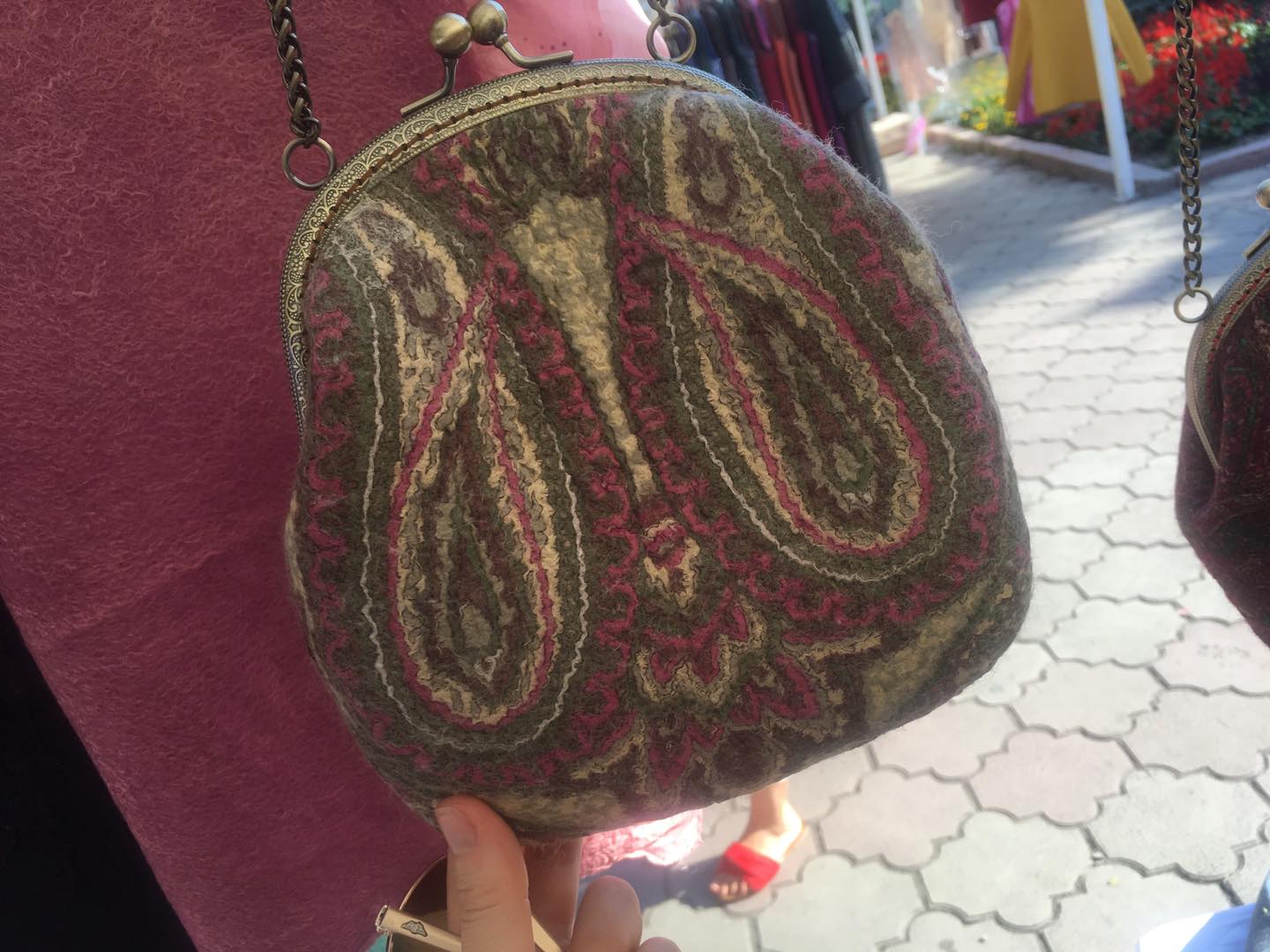
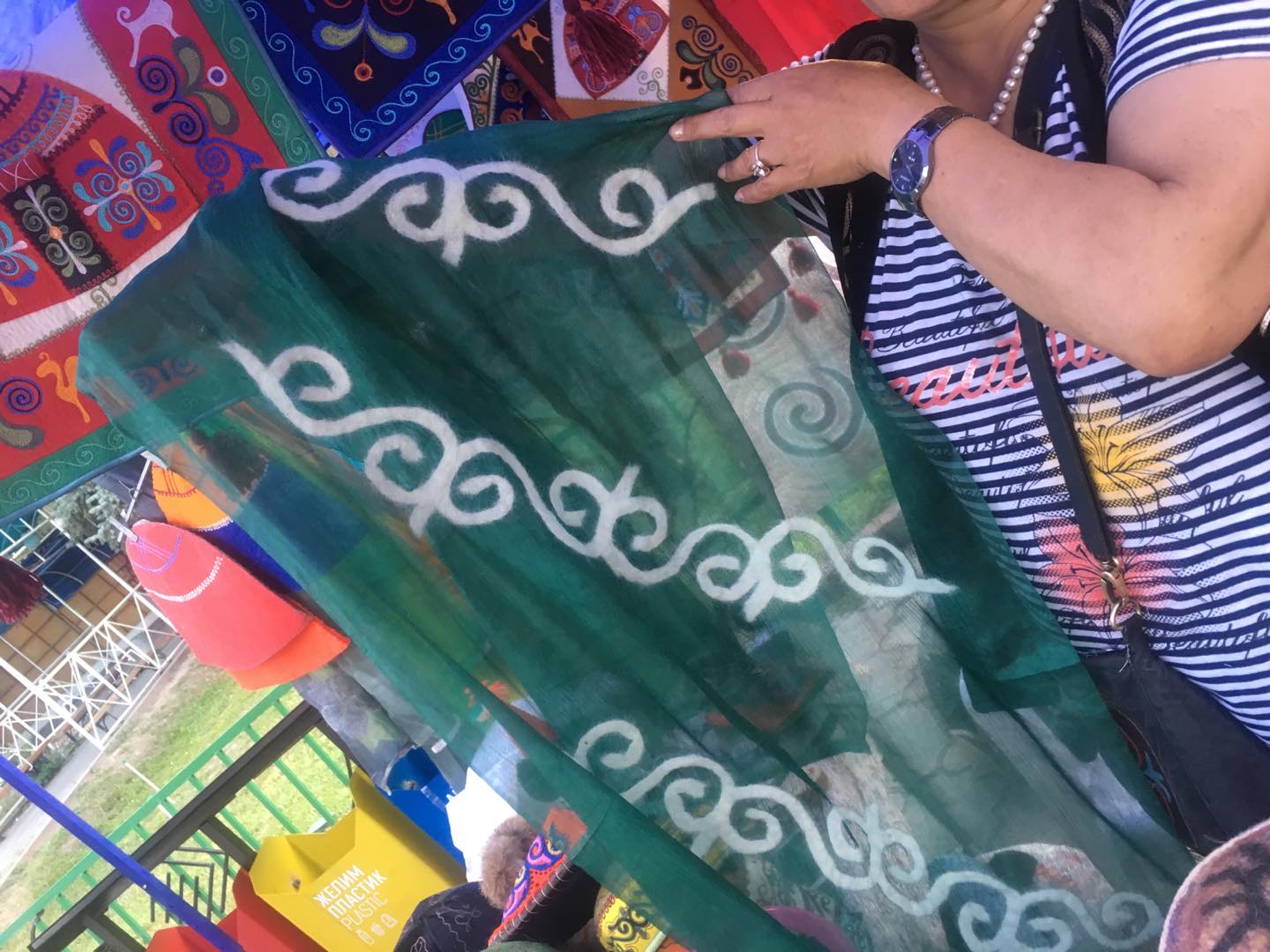
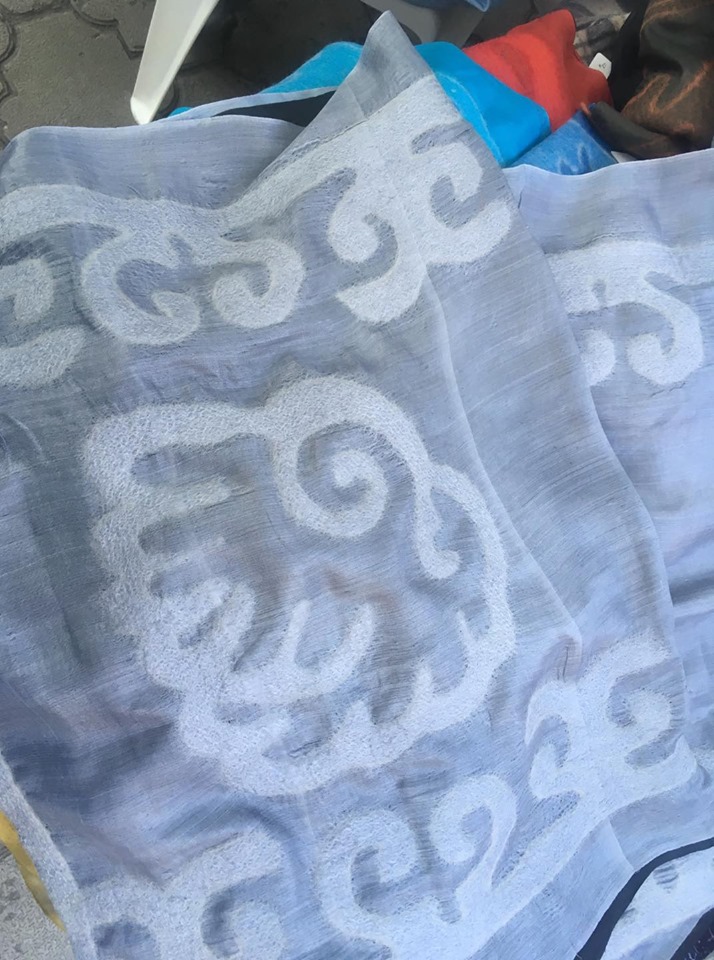
Felt clothing on the Kyrgyz market
This blog post will highlight some of the Kyrgyz designers who shape and innovate Kyrgyz fashion.
Farzana Sharshenbieva, founder of the 7sisters brand, is an artisan who knows how to mix traditional knowledge with innovative touch. She comes from creative family: her father is a well-known Kyrgyz artist and her mother taught embroidery in an art school.
Since 2011, Farzana and her fellow artisans have participated in the International Folk Art Market in Santa Fe, New Mexico, as well as exhibitions in the UK, Germany, Italy, UAE, and India. Farzana uses the Kyrgyz practice of making ala-kiyiz, in which a pattern of dyed wool is laid on a slightly rolled base, and then the felt is moistened and rolled again. By combining silk with felt, Farzana makes elegant clothing with an ala-kiyiz ornament. This work is both exclusive and complex as it is laboriously made without stitches or seams. Farzana was one of the pioneers of silk-felt clothing production in Kyrgyzstan. She started by manufacturing scarves and was soon joined by other artisans. Today, the bazaars in Bishkek and Osh are full of silk-felt scarfs. More recently, Farzana has begun to produce silk-felt jackets—a complex process that only a few other artisans have chosen to pursue—and the silk-felt handicrafts by 7sisters continue to differentiate themselves by maintaining a superior quality, finesse, and delicacy.
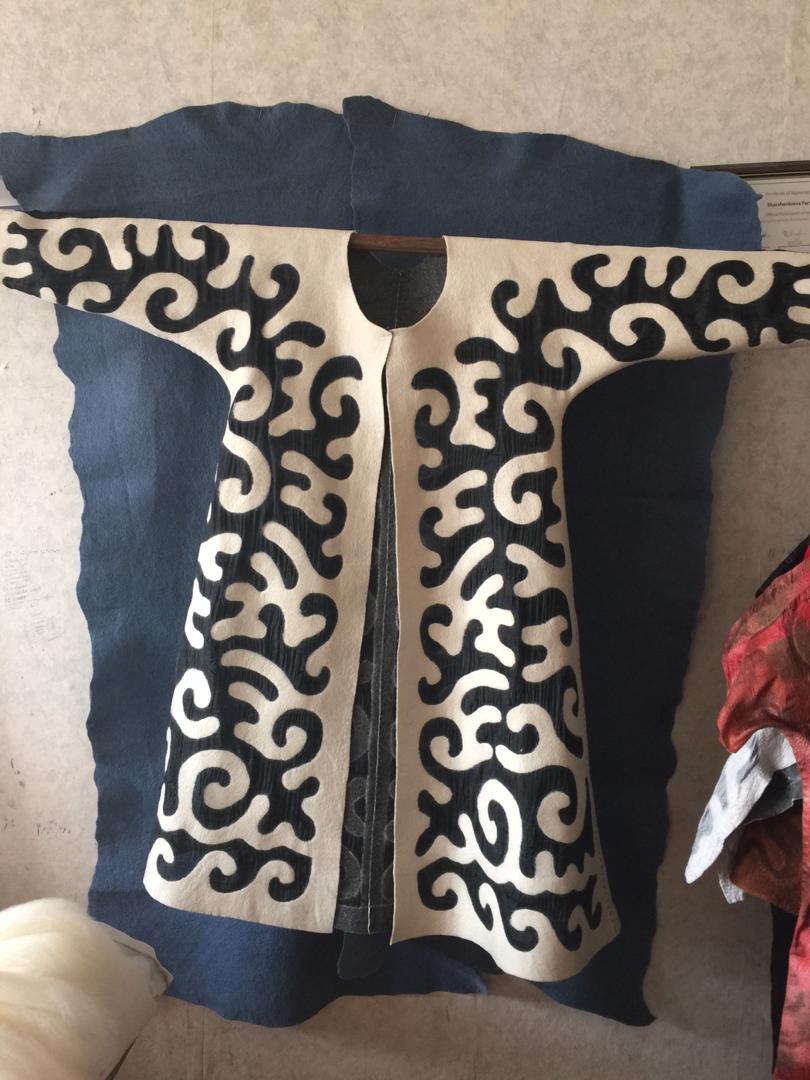
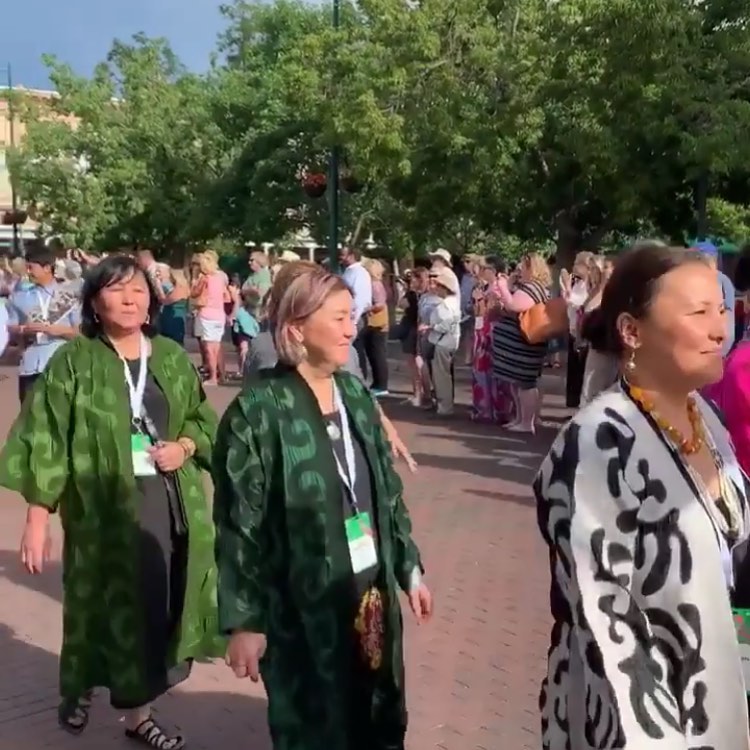
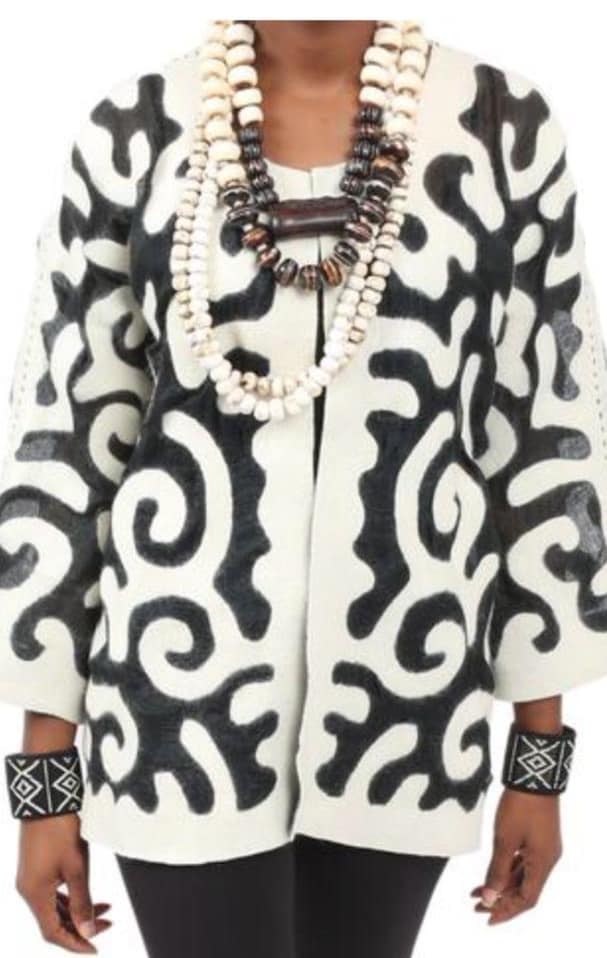
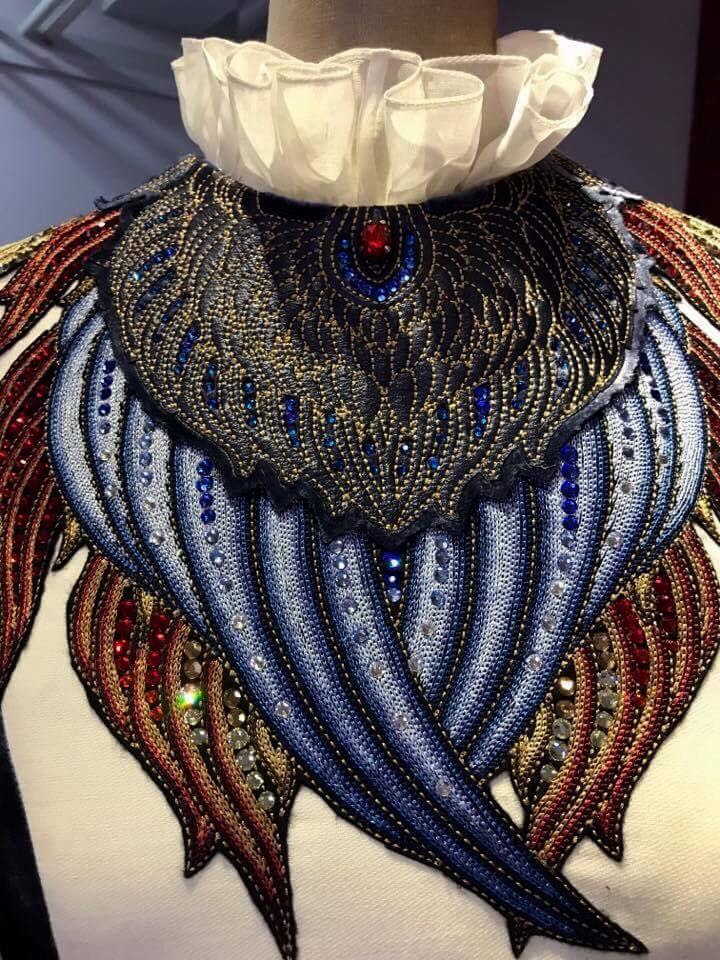
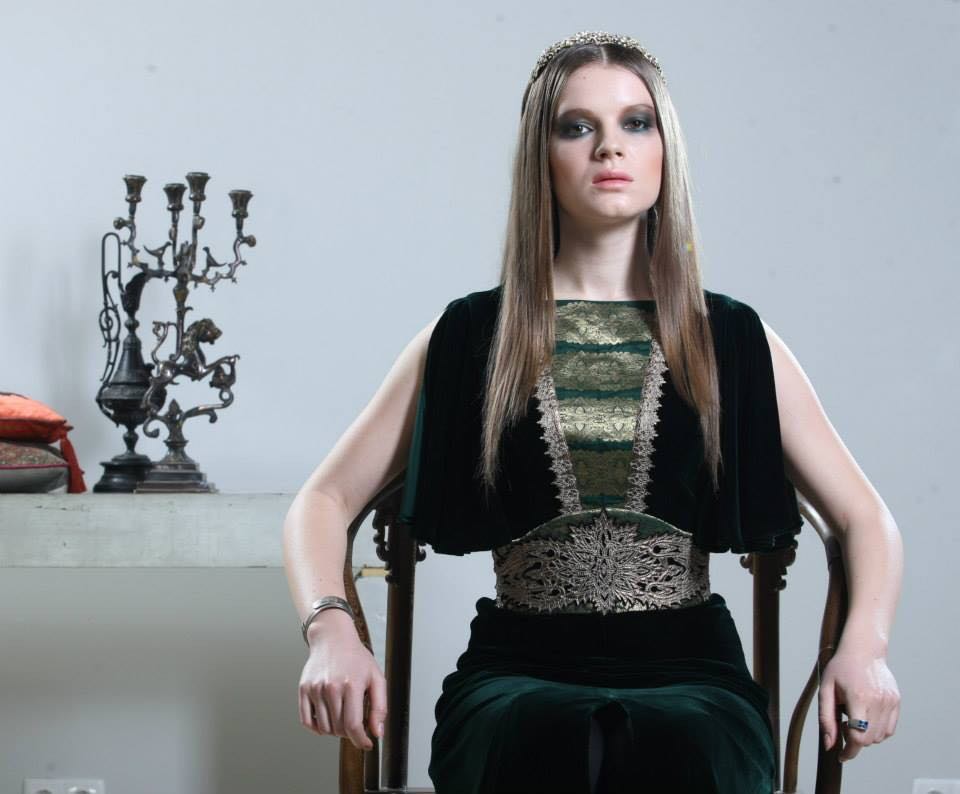
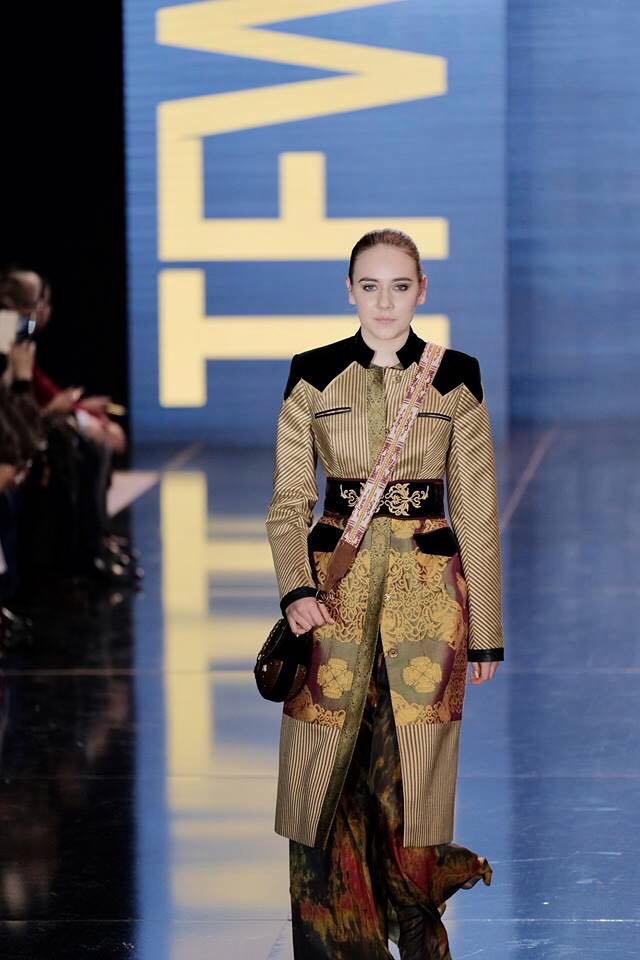
Clothing and accessories by Dilbar Ashimbaeva’s “Dilbar” brand are well-known in Kyrgyzstan and beyond.
Dilbar graduated from the A.N. Kosygin Moscow Textile Institute in 1990 and began designing footwear, leather clothes, and other accessories while also performing costume design for cinema and theater. Since 2000, she has primarily focused on her own brand, producing a new collection every year. Dilbar’s styles are influenced by different regions of South Asia, East Asia, and Central Asia. This influence can be seen in the choice of fabrics, embroidery techniques and motifs, and the cuts and shapes of clothing designs. Dilbar’s special garments include traditional tchapans in leather, modern-cut dresses in a combination of leather and jacquard with silk velvet and fine chiffon, and multi-layered embroidery and leather applications. While clothes by Dilbar are mostly reserved for special occasions, the cultural mix is harmonious and does not look too exotic or burlesque.
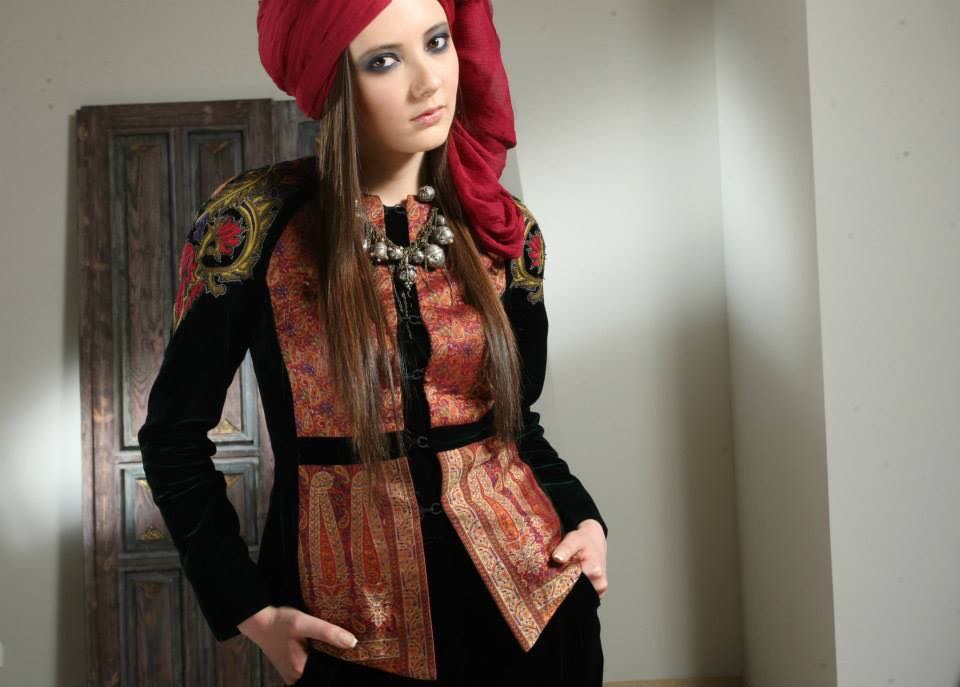
The women-run art group TUMAR was founded in 1997 by Chinara Makashova. The team consists of over 200 artists, designers, and craftsmen from across Kyrgyzstan that skillfully use traditional technologies and materials to create objects of modern life.
I learned of TUMAR’s respected reputation when I was conducting field research in the region of Issykul in 2017: I met a couple from Germany that credited TUMAR felt slippers as the reason they came to Kyrgyzstan. These comfortable shoes—along with felt bags and scarves—are in high demand among international clientele. The brand contributes to cherished Kyrgyz handicrafts and seeks to be Kyrgyzstan’s fashion ambassador to the world. Today, felt products by TUMAR are well known globally and have been exhibited and sold in Portugal, Germany, Japan, Italy, and the USA. TUMAR products are made of natural materials, helping the company to maintain an ecological balance and reduce the negative impact of the textile industry on the environment.
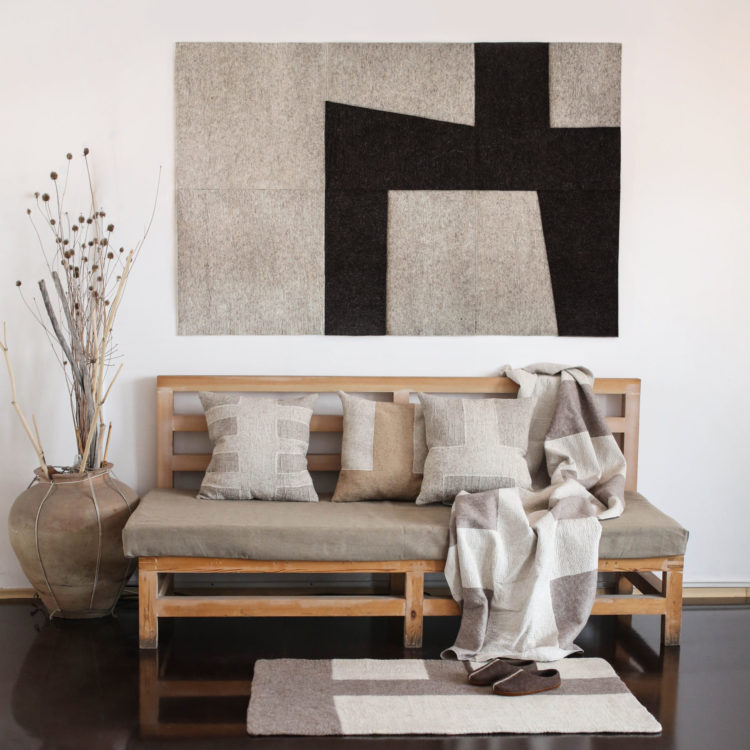

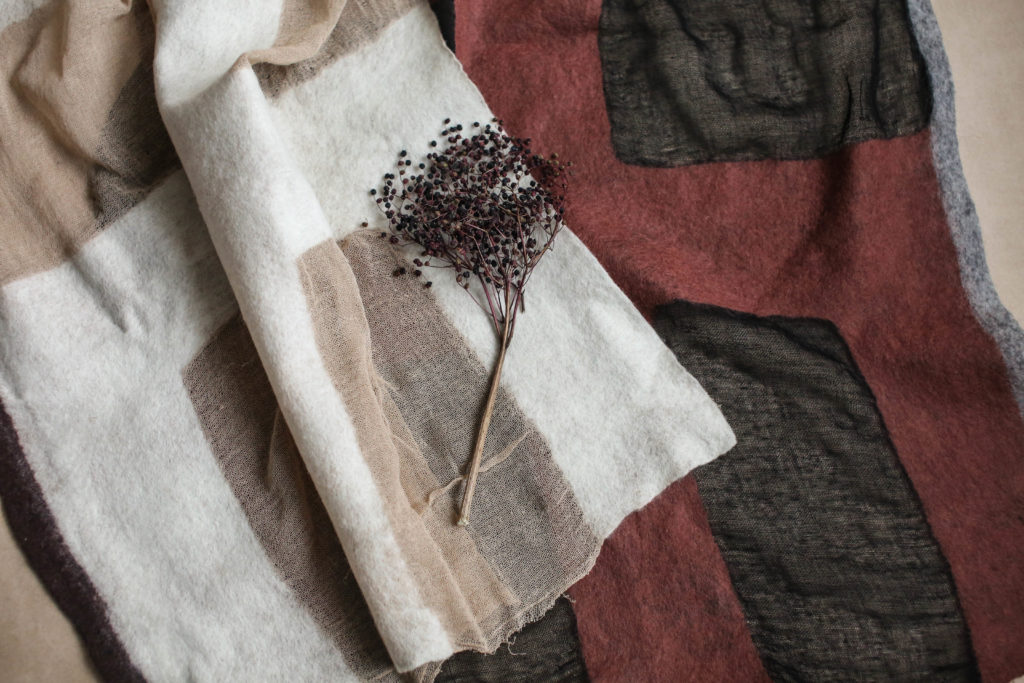
In creating their trendy, modern masterpieces, these designers are inspired by traditional techniques. They consult old photographs and ancient miniatures, collect vintage clothing, and draw from the volumes of literature devoted to Kyrgyz costume and ornamentation by Klavdiya Antipina, Mikhail Ryndin and other renowned ethnographers. TUMAR’s ability to appreciate traditional techniques and designs while boldly/smartly incorporating them into contemporary products helps the art group to distinguish itself from other artisans with a more narrow, traditional focus.
Asel Kalkanova is not a fashion designer. She has been restoring traditional garments for about 27 years. An experimented artisan, Asel restores traditional outfits piece by piece and can explain every detail of each garment.
Asel’s collection includes dozens of Kyrgyz clothing pieces and head coverings from the different regions of Kyrgyzstan, and she regularly participates in international festivals on traditional culture, demonstrating various Kyrgyz outfits and showing how to wear them. Together with Emil Tilekov, Ayday Asangulova, Nazira Momunbayeva, Asel participated in a 2013 project devoted to the reconstruction of eletchek – traditional headwear of a Kyrgyz woman. Later, in 2018, Emil and Asel initiated another project, “Ak Eletcheki. Enelerden Kalgan Myras.” They did a lot of work: casting models, creating traditional outfits from zero, and selecting new garments.
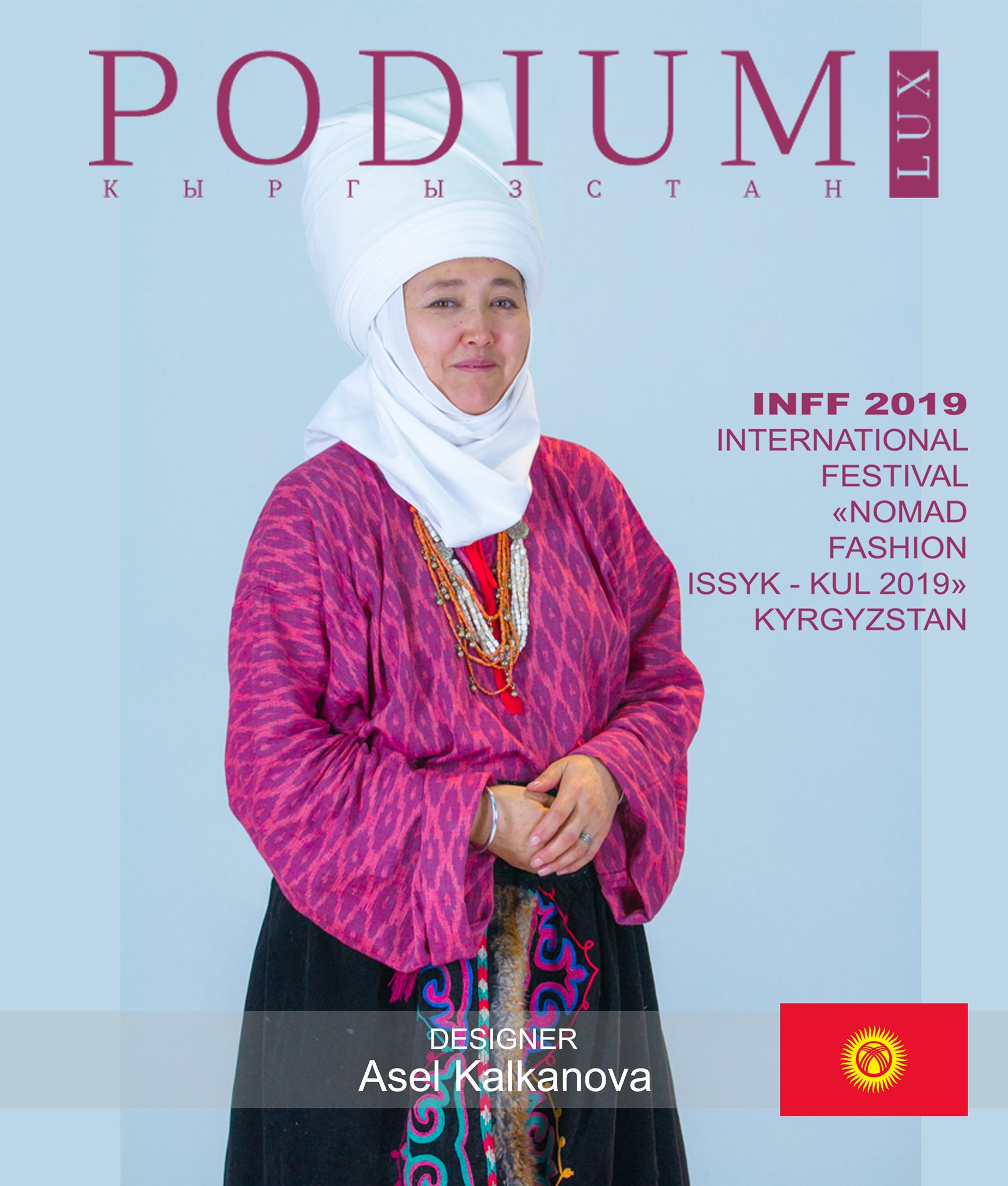
Emil Tilekov is a prominent researcher himself and studies Kyrgyz clothing traditions. One of the recent projects of Ak Eletcheki involved direct collaboration with a photographer and models and resulted in the publication of a 2019 calendar with twelve variations of eletchek from all over the country.
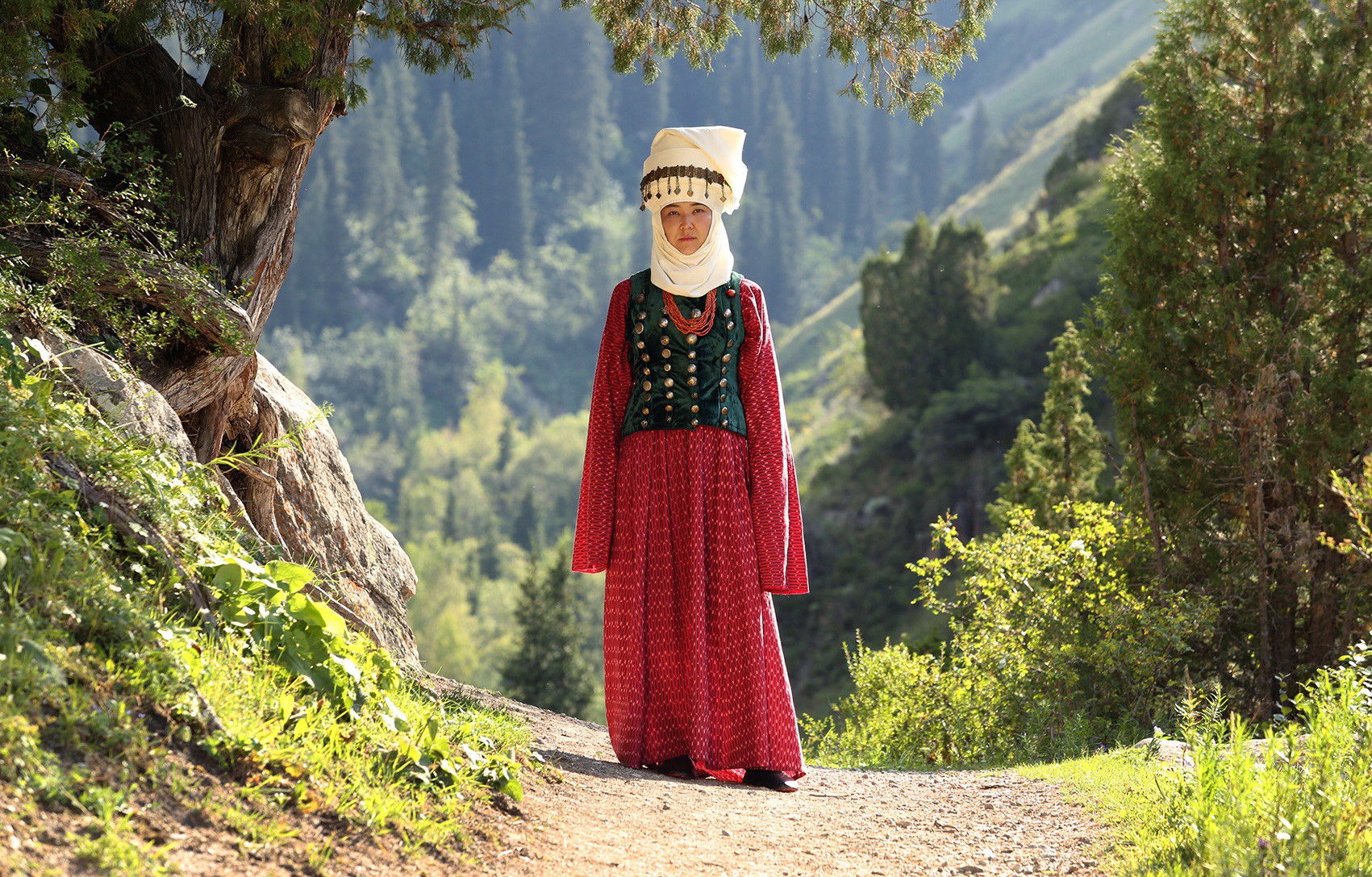

During my visit to Bishkek, I saw this modern version of kep-takyia in the city’s shopping centers. Interestingly, the vendors assured me that it is a Kyrgyz girl’s headwear and can be worn independently.[1] In recent collections, Kanyshay develops different looks that combine beadwork and velvet, fabric painting, and extravagant headwear. Oimok Art continues to draw inspiration from traditional clothing by presenting variations of kep takyia, tchyptama (jackets), and beldemtchi (skirts).
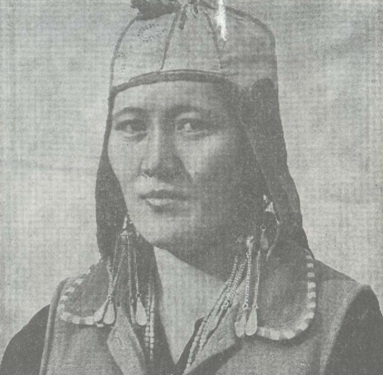
Kanyshay Rahimjanova is a young designer that has most recently showcased her work at the International Festival of National Garments in Shakhrisabz, Uzbekistan.
She demonstrated clothing manufactured in Kyrgyzstan’s ethnic style: long dresses and quilted jackets with inserts and inlays of kurak, or patchwork, with stylized kep takyia – Kyrgyz women’s headwear. Traditionally, kep takyia is designed to be worn under a turban of eletchek, but in modern Kyrgyzstan several designers—including Aijan Akylbekova (creator of Oimok Art)—present kep-takyia as a stand-alone headwear for unmarried girls.
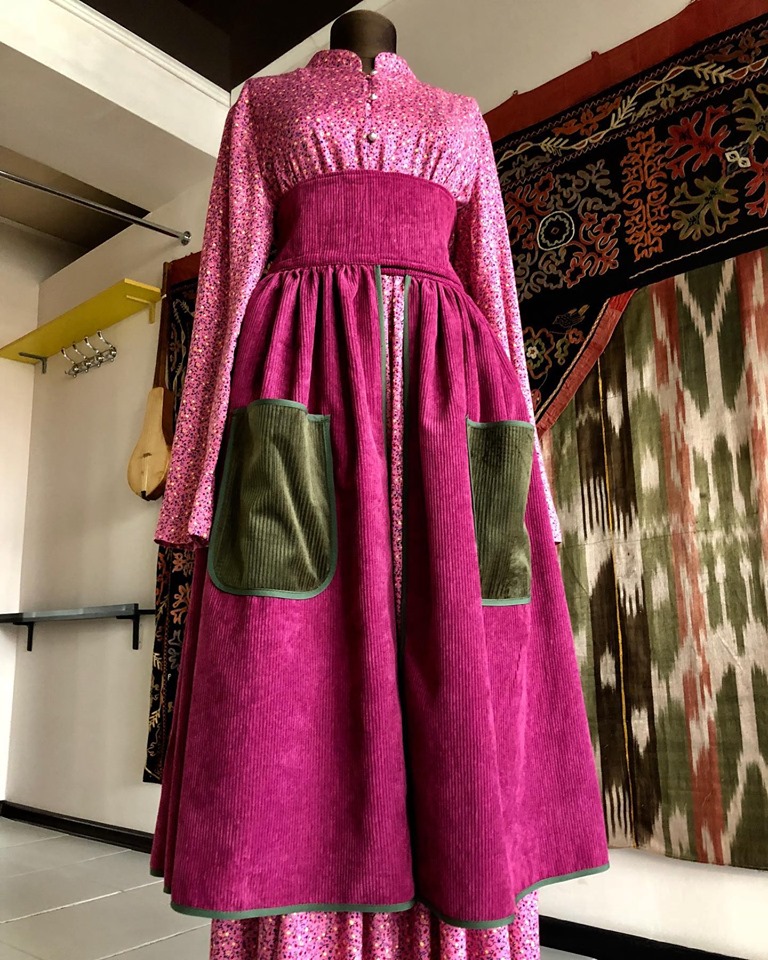
Nazgul Berbaeva is the founder of the Moimol H Heritage brand. Her clothing collections primarily include a classic European cut and style.
Though Nazgul usually avoids ethnic motifs, her 2015 collection is made of fabric with printed ethnic ornaments. The brand has also recently released a collection of silk scarves and organza skirts with black and white “Kyrgyz ornamentation.”
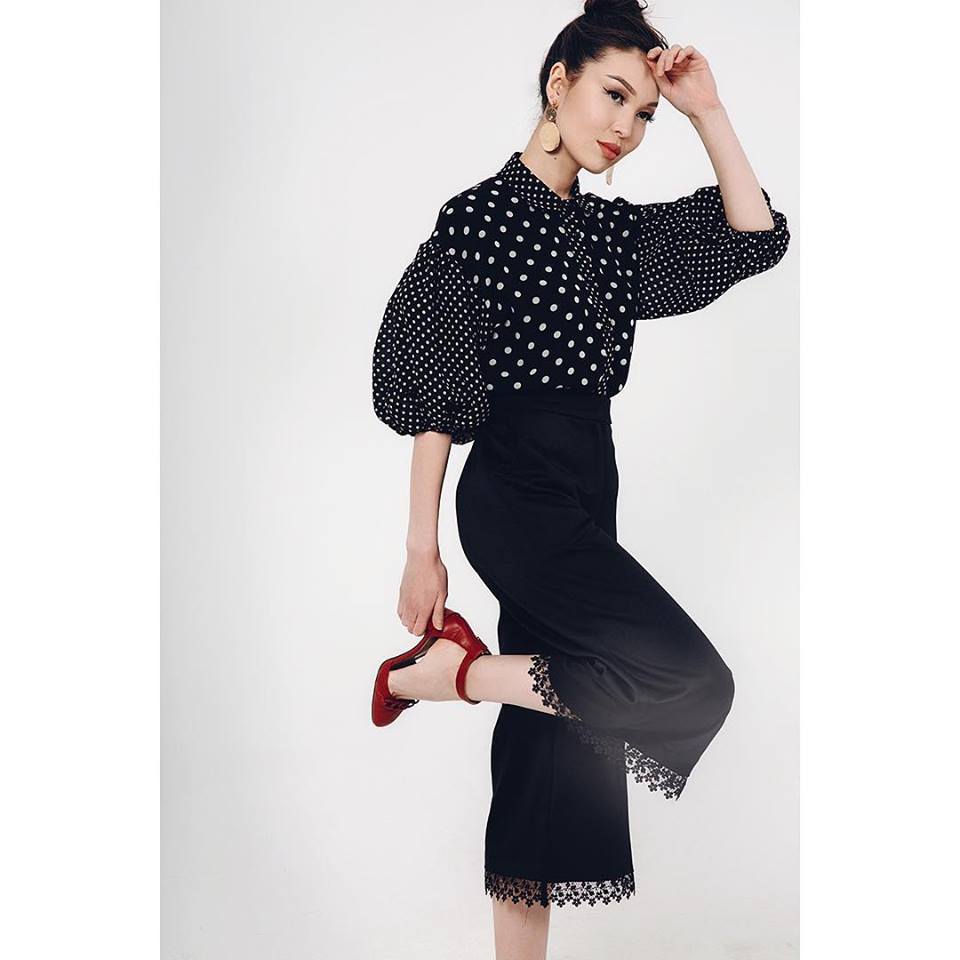
Printed, embroidered, or painted motifs can remind us of two key examples of Kyrgyz material culture that UNESCO has designated as Intangible Cultural Heritage elements: ala-kiyiz and shyrdak.
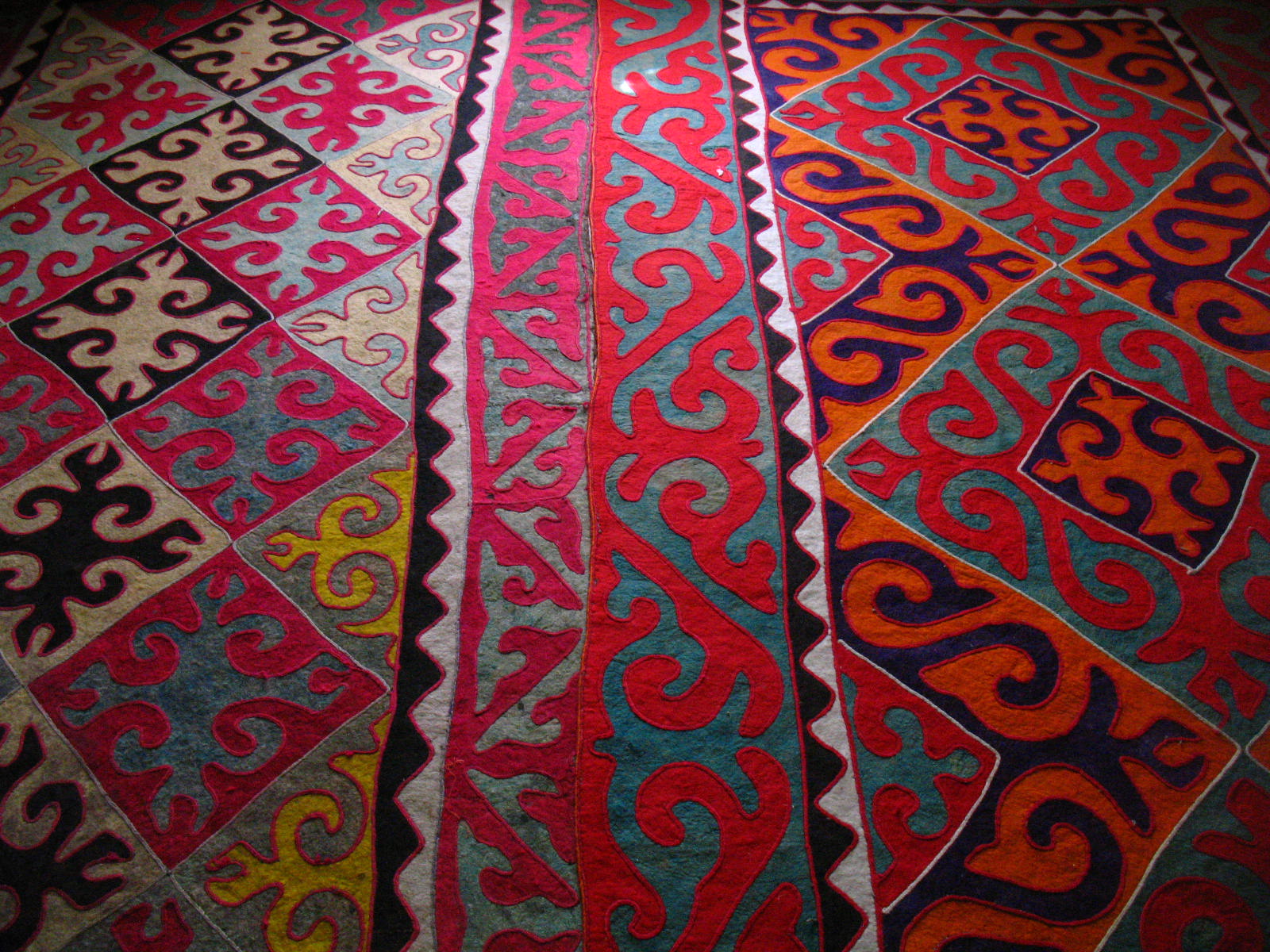
As archaeologist and orientalist Alexander Bernshtam states “visual folklore”[2] of Kyrgyz ornaments includes about 3,500 known semantic/visual combinations.[3] For example, a motif representing an eagle (буркут), together with a motif representing wooden grid that forms the walls of a yurt (корого), illustrates a popular Kyrghyz saying: “An eagle has a yurt in its heart.” A motif representing a gently blossoming flower (ачалып көле жаткан гул) with a motif representing a mountain goat’s head (кулжанын башы) illustrates a mountain sheep grazing on a jailoo in the spring.[4] These ornaments can be seen not only on tush-kiyiz, shyrdaks and ala-kiyiz, but also on coats, jackets, and scarves made by a talented artisans and designers. These items are not only elegant pieces of clothing, but also laconic narratives—or bayandama[5] in Kyrgyz.
For a country as small as Kyrgyzstan, there are many creative artisans and fashion designers, and this has been contributing to rapid development in the country’s conventional clothing industry.
Sonun Nurmanbetova (founder of the Sonun brand) is a designer inspired by elegant and classic looks—one might even call it a city chic style. Sonun is a co-founder of the showroom Modnyy Dom (Fashion House) in Bishkek. Modnyy Dom was founded together with Aysulu and Altynay Ryskulova in 2014 and was the first showroom in Bishkek. Initially, their showroom only held exhibits from established, recognized designers. Today, the showroom houses over 20 exhibits, including displays from young Kyrgyz designers as well as Kazakh and Georgian brands.
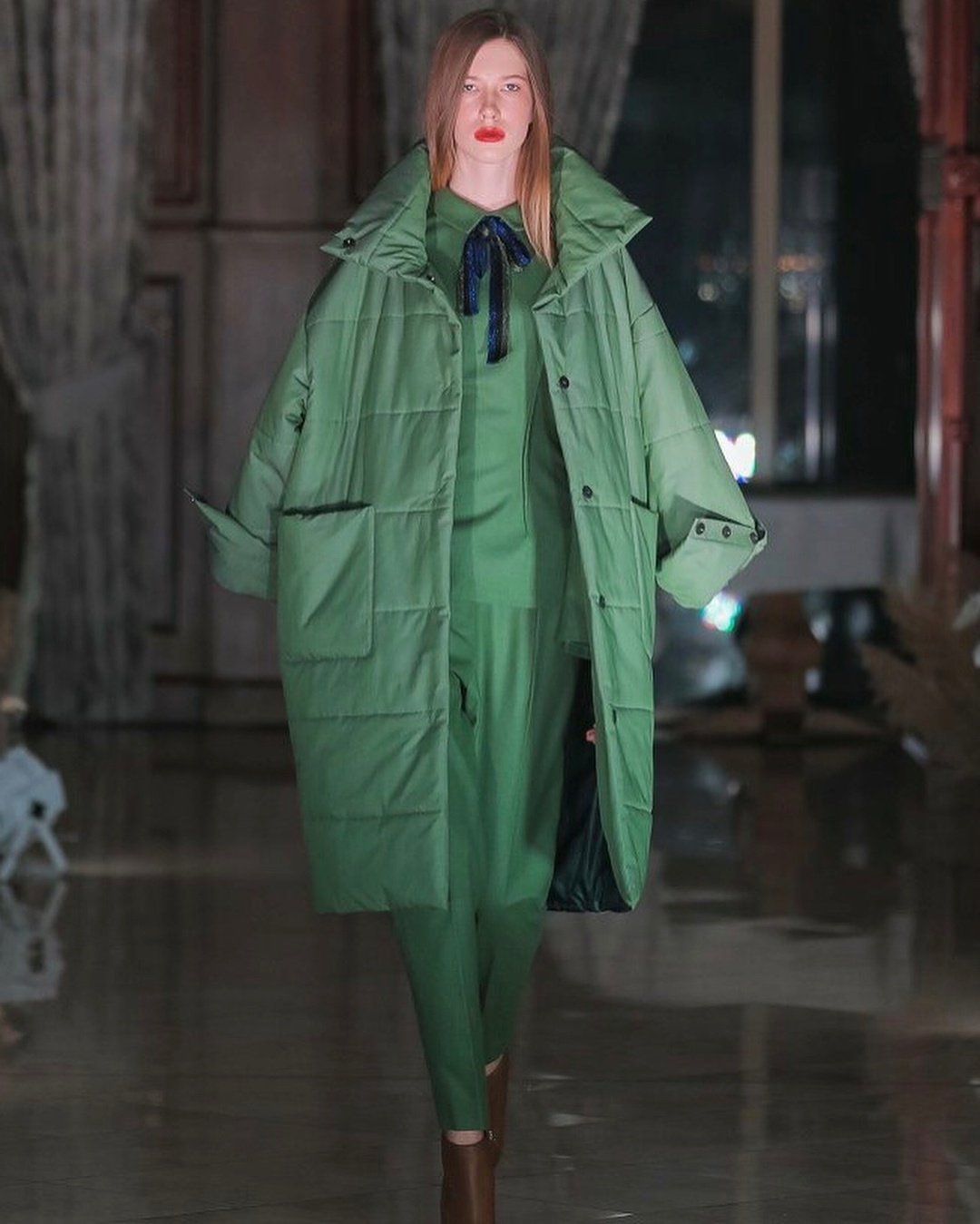
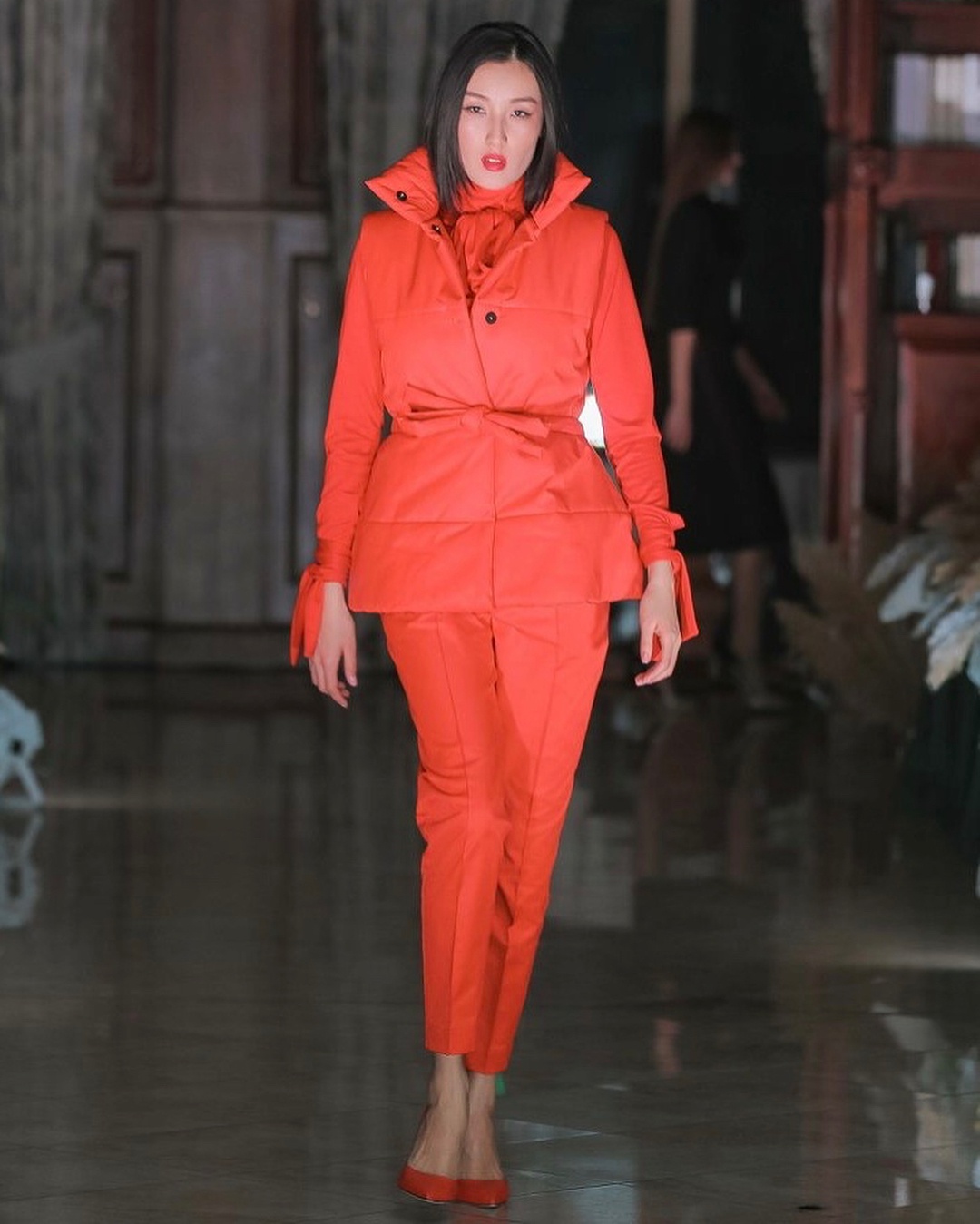
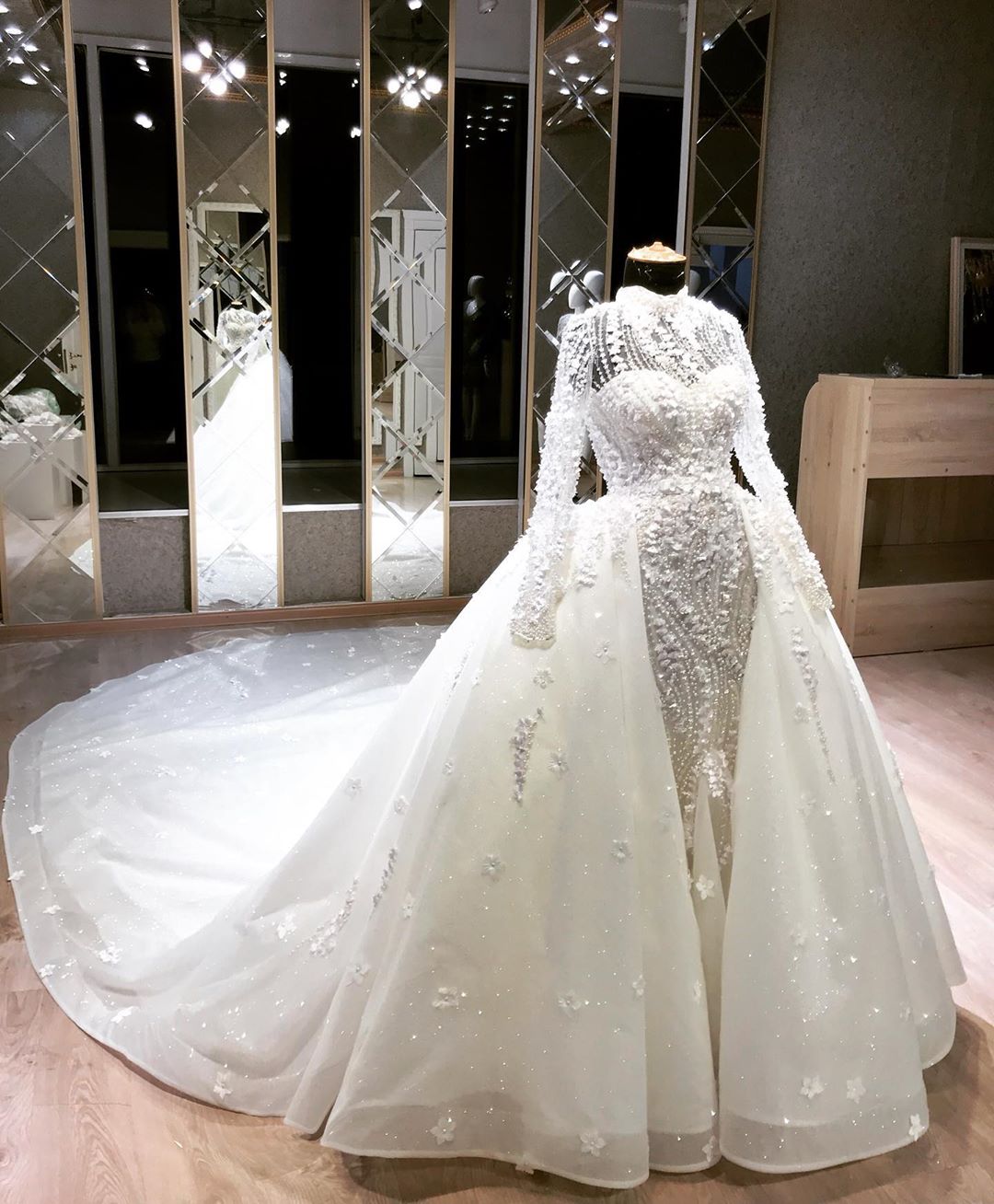
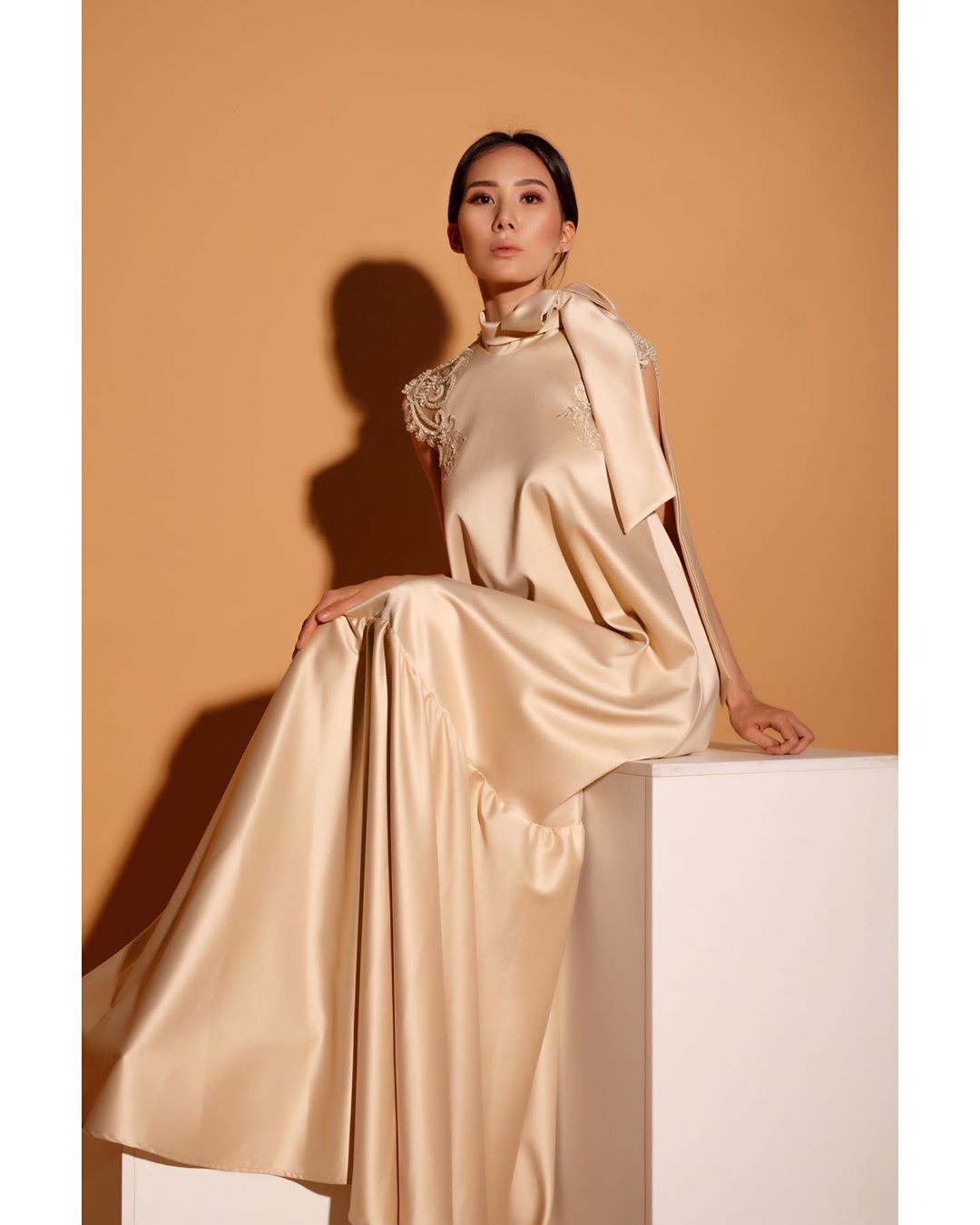
Naiyl Baykutchukov and Anvar Turdubaev both focus on evening and wedding gowns. Naiyl lives in Kazakhstan and owns three boutiques in Almaty, Astana, and Bishkek. Anvar graduated from the design faculty of the Kyrgyz Technical Univerity in Bishkek and subsequently founded his own studio in 2012. Both of these designers creates luxurious clothes for Kyrgyz fashionistas and exploit glamour as the source of their inspiration. Naiyl’s dresses have been embraced by Russian and Kazakh celebrities. These sophisticated dresses have a complex silhouette and are often covered with sequin and rhinestones, sometimes weighing up to 33 kilograms, or about 70 pounds!
Ayganysh Aripova graduated from Istituto Marangoni’s Milano School of Fashion and became a finalist of “Miss Kyrgyzstan” in 2011. The style of Aikin Aripova is difficult to pinpoint: the baby-doll and new age styles are mixed with oversized coats, while some of the more glamorous looks are accompanied with romantic feminine clothes. Some Aikin Aripova outfits are styled with handbags by Damelka, a brand founded by Saikal Mederova and Alina Yusupova. Every bag has the same shape, but each one is uniquely painted.

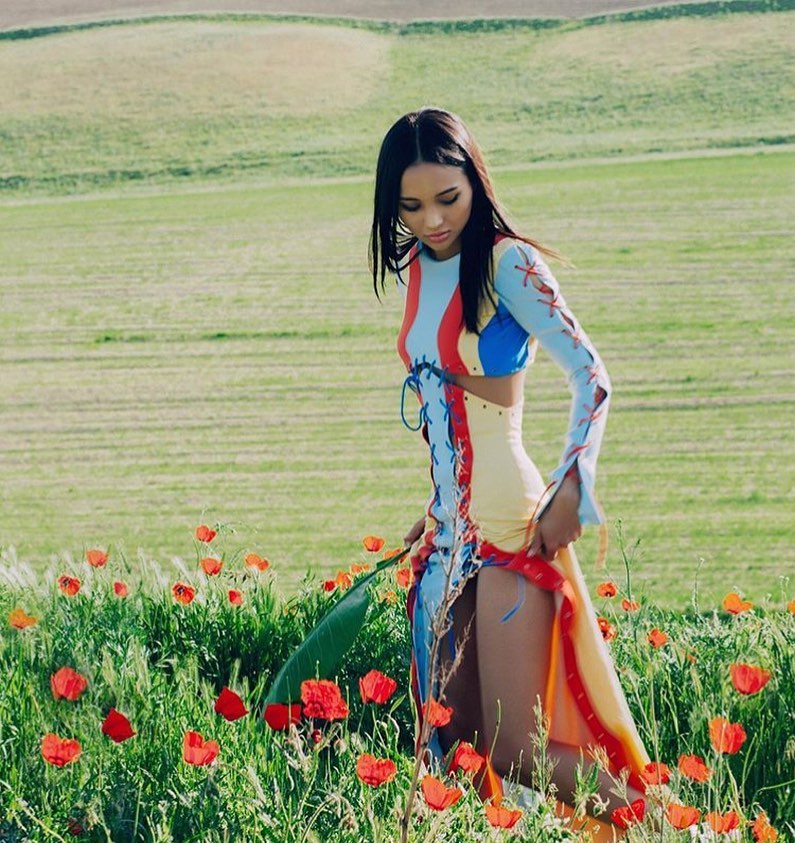
Garment manufacturing in Kyrgyzstan is a prominent and fast growing industry that has grown from the margins of trade in small bazaars full of Chinese-made clothing to a robust network of hundreds of clothing shops, employing around 200,000 people (predominantly women) with a net export production worth over $100 million dollars (according to Kyrgyz national statistics, the garment exports in 2017 totaled $137 million). The industry has been and will continued to be inspired by its talented designers, skillful artisans, and spectacular traditions.
[1] Interview with vendors at the shopping centres Caravan, Beta Stores, June-July 2019
[2] Kyrgyz national ornament (Кыргызский национальный узор). The materials have been collected and processed by artist М. V. Ryndin. I.A. Orbeli (ed). Leningrad-Frunze: 1948. p.29
[3] Kyrgyz national ornament (Кыргызский национальный узор). The materials have been collected and processed by artist М. V. Ryndin. I.A. Orbeli (ed). Leningrad-Frunze: 1948. p.36
[4] Kyrgyz national ornament (Кыргызский национальный узор). The materials have been collected and processed by artist М. V. Ryndin. I.A. Orbeli (ed). Leningrad-Frunze: 1948.
[5] Bayandama (баяндама)– translated from Kyrgyz as narrative

By Snezhana Atanova
Snezhana Atanova is a PhD candidate at INALCO. Her thesis focuses on nationalism and cultural heritage in Central Asia. She recently finished an IFEAC fellowship devoted to national identity in everyday life in Kyrgyzstan and Turkmenistan. She was awarded a Carnegie fellowship in 2017, in which she explored national identity through the nation-branding initiatives of Russia and Central Asian countries. She earned a Master’s in International Communication from the University of Strasbourg in 2012 and a Master’s from the National Institute of Oriental Languages and Civilizations (INALCO) in 2015.
